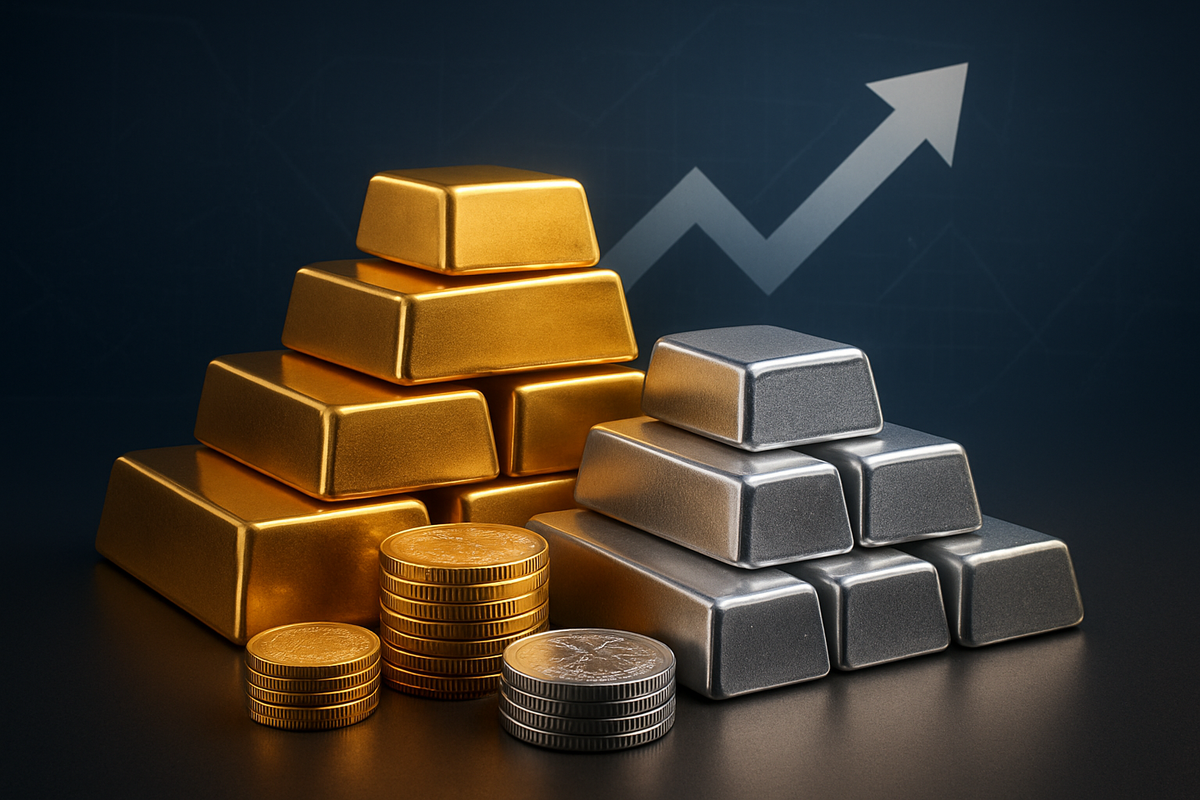
New York, NY – November 28, 2025 – Gold and silver prices have reached unprecedented highs in the domestic futures market, driven by a powerful confluence of strong spot demand across diverse sectors and the escalating anticipation of an interest rate cut by the US Federal Reserve. This rally underscores the enduring appeal of precious metals as both safe-haven assets and critical industrial commodities, sending significant ripple effects throughout global financial markets.
The surge, which has seen gold surpass $4,300 per ounce and silver breach $55 per ounce earlier in October, reflects a market grappling with persistent geopolitical uncertainties, inflationary pressures, and a shifting monetary policy landscape. As investors and central banks alike flock to these tangible assets, the immediate implications point towards sustained bullish momentum for precious metals, heightened market volatility, and a re-evaluation of investment strategies in a potentially lower-yield environment.
Unpacking the Precious Metals Phenomenon: A Detailed Look at the Rally
The year 2025 has been nothing short of historic for precious metals. Gold has charted a remarkable upward trajectory, consistently setting new records and surpassing $4,300 per ounce in October, now hovering around $4,160-$4,171 per ounce as of November 28, 2025. This performance positions gold for what analysts predict could be its strongest annual showing since 1979, cementing its role as a premier store of value. Silver's ascent has been even more dramatic in percentage terms, hitting all-time records above $54 per ounce in October and nearing $55.86 per ounce today, boasting impressive year-to-date gains exceeding 81%.
This rally is fundamentally rooted in robust demand. Central banks globally have been prodigious accumulators of gold, projected to average around 900 tonnes in 2025, driven by strategic diversification away from US dollar reserves and heightened geopolitical tensions. Investor interest, both institutional and retail, has also been fervent, with Exchange-Traded Funds (ETFs) experiencing substantial inflows. For silver, industrial consumption remains a powerhouse, accounting for 59-60% of global demand. Key sectors like solar panel manufacturing and electric vehicles are voracious consumers, pushing industrial demand to new records. Compounding this, the silver market has faced structural supply deficits since 2021, a trend expected to continue as mine supply struggles to keep pace, leading to declining inventories in major warehouses.
A pivotal catalyst for this surge is the widespread expectation of a US interest rate cut by the Federal Reserve. Market traders are assigning a high probability (80-87%) to a 25-basis-point cut in December 2025, with further reductions anticipated in 2026. Lower interest rates diminish the opportunity cost of holding non-yielding assets like gold and silver, making them more attractive compared to interest-bearing alternatives. This dovish outlook has also contributed to a weaker US dollar, making dollar-denominated precious metals more affordable for international buyers. The recent hours-long halt in futures trading on the CME's Comex Exchange on November 28, 2025, due to a cooling system failure, added a layer of market volatility and highlighted vulnerabilities, though the underlying bullish sentiment for precious metals remained unshaken.
Winners and Losers: Corporate Impacts of the Precious Metals Boom
The sustained rally in gold and silver prices presents a clear dichotomy of fortunes for various public companies. Mining companies, particularly those focused on precious metals extraction, stand to be significant beneficiaries. Companies like Barrick Gold Corp. (NYSE: GOLD), Newmont Corporation (NYSE: NEM), and Agnico Eagle Mines Limited (NYSE: AEM) are poised for enhanced profitability as the value of their primary products skyrockets. Higher commodity prices directly translate to increased revenue per ounce or gram sold, improving their margins, cash flows, and potentially allowing for increased exploration and development budgets. Similarly, silver producers such as Pan American Silver Corp. (NASDAQ: PAAS) and Hecla Mining Company (NYSE: HL) will see substantial upside, especially given silver's dual role in industrial applications, which provides an additional layer of demand stability.
Conversely, industries heavily reliant on gold and silver as raw materials might face increased operational costs. Jewelers, for instance, particularly those specializing in high-end gold and silver pieces, could see their input costs rise significantly. While some of these costs might be passed on to consumers, there's a risk of dampened demand if prices become prohibitive. Companies like Tiffany & Co. (NYSE: TIF) (a subsidiary of LVMH) or smaller, independent jewelers might need to adjust their pricing strategies or explore alternative materials. Electronics manufacturers, especially those producing solar panels or advanced 5G and AI devices, also use substantial amounts of silver. While demand in these sectors is robust, the rising cost of silver could marginally squeeze profit margins for companies like First Solar, Inc. (NASDAQ: FSLR) or various semiconductor manufacturers, unless they can efficiently hedge their commodity exposure or innovate to reduce silver content.
Investment firms and asset managers with significant exposure to precious metals through ETFs or direct holdings are also clear winners. Firms managing gold and silver-backed ETFs will see their assets under management grow, benefiting from increased fees. However, companies that have bet against precious metals or are heavily weighted in interest-rate-sensitive assets that perform poorly in a low-rate environment might experience headwinds. Furthermore, the broader financial services sector could see a shift in investment flows, with capital moving away from traditional fixed-income instruments towards commodities and inflation hedges, prompting strategic adjustments in portfolio allocations across the industry.
Broader Significance: A Shifting Economic Landscape
The current surge in gold and silver prices is not an isolated event but rather a significant indicator of broader shifts within the global economic and financial landscape. This rally strongly aligns with a growing trend of de-dollarization among central banks, who are increasingly diversifying their reserves away from the US dollar and into gold. This strategic move is fueled by geopolitical uncertainties, including ongoing trade tensions, conflicts in Ukraine and the Middle East, and concerns over the stability of the international financial system. The consistent accumulation of gold by central banks underscores a fundamental re-evaluation of reserve assets and a move towards tangible stores of value.
The ripple effects of this precious metals boom extend to various sectors. In the commodity market, it reinforces the outperformance of precious and transition metals within indices like the Bloomberg Commodity Total Return Index. This trend is further bolstered by concerns over US debt levels and the demand for debasement hedges. For fixed income markets, lower real yields diminish the attractiveness of interest-bearing Treasury securities, potentially diverting capital towards non-yielding assets like gold, creating a challenging environment for bond investors. Regulatory or policy implications could arise if governments perceive the de-dollarization trend as a threat to financial stability, potentially leading to discussions or policies aimed at shoring up confidence in fiat currencies or managing commodity market volatility.
Historically, periods of significant precious metal appreciation often coincide with economic uncertainty, inflationary pressures, or periods of monetary easing. The current environment, marked by anticipated rate cuts, geopolitical instability, and persistent inflation concerns, echoes historical precedents where gold and silver have served as reliable hedges. For instance, the late 1970s, a period of high inflation and geopolitical turmoil, saw a similar strong performance in gold. The current scenario suggests a similar flight to safety and a vote of no confidence in the long-term purchasing power of fiat currencies amidst unprecedented global debt levels. This event signals a fundamental shift in investor sentiment, prioritizing capital preservation and inflation protection over traditional yield-seeking strategies.
What Comes Next: Navigating the Future of Precious Metals
Looking ahead, the short-term outlook for gold and silver remains overwhelmingly bullish. Analysts widely anticipate continued support for both metals, with strong demand from central banks and investors likely to persist through the end of 2025 and into 2026. The high probability of a December US interest rate cut will likely act as an immediate catalyst, further reducing the opportunity cost of holding non-yielding assets and potentially weakening the US dollar, thereby boosting international demand. In the short term, investors should watch for any shifts in Federal Reserve rhetoric or economic data that might alter rate cut expectations, as these could introduce temporary volatility. However, the underlying demand drivers appear robust enough to absorb minor fluctuations.
In the long term, the trajectory for precious metals appears to be upward, albeit with potential for consolidation phases. Forecasts for gold range between $4,000 and $5,300 per ounce next year, with silver potentially exceeding $52.50 in 2026. This sustained bullish outlook is underpinned by ongoing central bank demand, structural supply constraints for silver, and the broader accommodative monetary policies expected globally. Strategic pivots or adaptations required from companies will include mining firms focusing on maximizing production efficiency and exploring new deposits, while industrial users of silver may need to enhance hedging strategies or invest in material science to reduce reliance on the metal.
Market opportunities will emerge for investors in precious metal ETFs, mining company equities, and potentially physical metal holdings. Challenges could include increased market volatility, potential for speculative bubbles, and the risk of a sudden shift in monetary policy if inflation proves more stubborn than anticipated. Potential scenarios include a continued "goldilocks" scenario where rate cuts provide a tailwind without triggering significant economic downturns, or a more turbulent environment where heightened geopolitical risks further amplify safe-haven demand. The outcomes will largely depend on the interplay between central bank actions, global economic health, and geopolitical developments.
A Comprehensive Wrap-Up: Enduring Significance and Investor Watchpoints
In summary, the recent surge in gold and silver prices is a multifaceted phenomenon driven by an potent combination of robust global demand and the strong anticipation of a US interest rate cut. Key takeaways include the reassertion of precious metals as crucial safe-haven assets amidst geopolitical uncertainty, the significant role of central bank accumulation, and the persistent supply deficits in the silver market. The impending shift in US monetary policy, moving towards lower interest rates, further enhances the attractiveness of these non-yielding assets by reducing their opportunity cost and potentially weakening the US dollar.
Moving forward, the market appears poised for continued strength in precious metals. The structural drivers behind this rally, including sustained demand from both investors and industries, coupled with a more accommodative monetary policy environment, suggest that this is more than just a fleeting trend. The immediate future will likely see further price appreciation, though investors should remain vigilant for any shifts in economic indicators or central bank communications that could influence market sentiment.
The lasting impact of this event will likely be a reinforced perception of gold and silver as essential components of diversified portfolios, particularly in an era characterized by elevated debt, inflation concerns, and geopolitical instability. For investors, the coming months will be critical to watch for further pronouncements from the Federal Reserve, the trajectory of inflation, and any developments in global geopolitical hotspots. These factors will continue to shape the narrative for precious metals, influencing their role as both an investment vehicle and a hedge against uncertainty.
This content is intended for informational purposes only and is not financial advice






